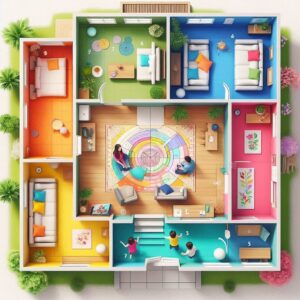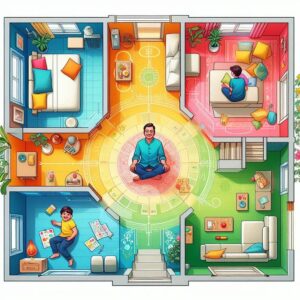Have you ever walked into a room and instantly felt a sense of calm or invigorated energy? Colors have a profound effect on our moods and emotions. Vastu Shastra, the ancient Indian system of architecture and design, recognizes this connection and prescribes specific colors for different zones in your home to create a harmonious and balanced environment.

Understanding Vastu Zones:
Vastu divides your home into eight cardinal and four sub-cardinal directions, each with a specific energy and governing element. These zones are believed to influence various aspects of your life, from health and wealth to relationships and peace of mind.
- North: This zone, ruled by the water element, is associated with career growth, prosperity, and spiritual development.
- East: Governed by the air element, the east zone promotes good health, fresh beginnings, and positive energy.
- South: The fire element reigns supreme in the south zone, influencing passion, energy, and recognition.
- West: Associated with the earth element, the west zone governs relationships, creativity, and peace.
- Northeast: This zone, ruled by the space element, is linked to spiritual growth, knowledge, and intuition.
- Southeast: The fire element extends to the southeast zone, influencing success, fame, and self-confidence.
- Southwest: Governed by the earth element, the southwest zone promotes stability, grounding, and relationships.
- Northwest: This zone, ruled by the air element, is associated with progress, travel, and ambition.
Colors for Harmony:
Now that you understand the zones, let's explore the colors recommended by Vastu for each:
- North Zone: Light and cool colors like light blue, teal, and white are ideal for the north zone. These promote a sense of calmness, focus, and mental clarity, aiding in career pursuits and spiritual growth.
- East Zone: Light and refreshing colors like green, yellow, and light blue are recommended for the east zone. These vibrant hues symbolize new beginnings, good health, and positive energy, creating an uplifting atmosphere.
- South Zone: Warmer and brighter colors like red, orange, and yellow are well-suited for the south zone. These colors represent fire and passion, fostering energy, vitality, and recognition. However, use them in moderation to avoid an overpowering effect.
- West Zone: Light and soothing colors like cream, beige, and light green are ideal for the west zone. These promote peace, relaxation, and strengthen relationships.
- Northeast Zone: Light and airy colors like white, cream, and light yellow are recommended for the northeast zone. These colors enhance knowledge, intuition, and spiritual connection.
- Southeast Zone: Warmer and outgoing colors like orange, pink, and light yellow are well-suited for the southeast zone. These vibrant hues represent success, fame, and self-confidence.
- Southwest Zone: Earthy and calming colors like beige, cream, and light brown are ideal for the southwest zone. These promote stability, grounding, and healthy relationships.
- Northwest Zone: Light and airy colors like white, cream, and light blue are recommended for the northwest zone. These colors enhance progress, communication, and ambition.
Read Also:- Optimal Lift Position As Per Vastu For Positive Energy And Harmony
Beyond the Basics:
While these are general recommendations, Vastu also considers subtler aspects. Here are some additional tips:
- Balance is Key: Avoid using too much of a single color in a zone. Create a balance with lighter or darker shades to maintain harmony.
- Consider the Purpose: Choose colors that complement the intended purpose of the room. For example, calming blues in the bedroom and stimulating yellows in the study.
- Natural Light Matters: The amount of natural light a zone receives can influence your color choices. Opt for lighter colors in rooms with less natural light.
- Personal Preferences: Ultimately, your comfort matters most. While Vastu offers guidance, don't be afraid to incorporate colors you personally find pleasing.

Creating a Flow:
Vastu emphasizes the importance of creating a flow of energy throughout your home. When choosing colors, consider how they transition from one zone to another. Avoid drastic color changes between adjacent zones, as this can create a sense of disharmony.
Beyond Colors:
Remember, Vastu is a holistic system that goes beyond colors. Here are some additional elements to consider for a balanced home:
- Placement of furniture: Arrange furniture in a way that promotes the flow of energy and avoids blocking doorways.
- Decluttering: Get rid of clutter and unnecessary items to create a sense of spaciousness and positivity.
- Natural elements: Incorporate plants and natural materials like wood and stone to bring life and grounding energy to your space.
By understanding the connection between Vastu zones and colors, you can mindfully create a space that supports your well-being and aspirations. Remember, Vastu is not about rigid rules, but rather a guide to creating a home that feels balanced, uplifting, and uniquely yours. So, experiment with colors, incorporate Vastu principles where they resonate with you, and most importantly, enjoy the process of creating a home that reflects your inner harmony.
Embracing the Journey:
Vastu is an ongoing practice, not a one-time fix. As your life evolves, your needs for your home space may change as well. Regularly assess your space, make adjustments as needed, and don't hesitate to seek guidance from a Vastu consultant for more personalized recommendations.
Wrapping up
While Vastu offers valuable insights, it's important to remember that it's just one piece of the puzzle. Combine Vastu principles with your own design sensibilities, cultural influences, and practical considerations to create a home that truly reflects your unique style and fosters a sense of well-being for you and your loved ones.


